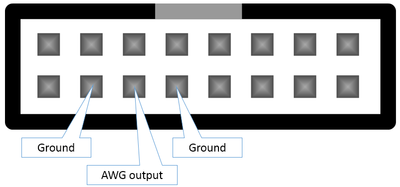Arbitrary Waveform Generator (AWG): Difference between revisions
Jump to navigation
Jump to search
JamesNewton (talk | contribs) m (JamesNewton moved page Arbitraty Waveform Generator (AWG) to Arbitrary Waveform Generator (AWG): Misspelling of Arbitrary as Arbitraty in page name.) |
JamesNewton (talk | contribs) |
||
| Line 1: | Line 1: | ||
The SmartScope has an Arbitrary waveform generator, capable of generating signals between the [0V, 3.3V] voltage range at a sample rate of 100MS/s. | The SmartScope has an Arbitrary waveform generator, capable of generating signals between the [0V, 3.3V] voltage range at a sample rate of 100MS/s. | ||
= AWG pin location = | = AWG pin location = | ||
The signal generated by the AWG is presented on the 3rd-left pin on the bottom row of the '''AUX connector''', as shown in the following image:<br> | The signal generated by the AWG is presented on the 3rd-left pin on the bottom row of the [[AUX_connector_pinout|'''AUX connector''']], as shown in the following image:<br> | ||
[[File:AWGoutput.png|400px]]<br> | [[File:AWGoutput.png|400px]]<br> | ||
Please keep in mind that you always should bridge 2 wires between 2 separate devices. In this case: | Please keep in mind that you always should bridge 2 wires between 2 separate devices. In this case: | ||
| Line 7: | Line 7: | ||
* The ground, so both devices have the same reference voltage. (0V means the same on both devices) | * The ground, so both devices have the same reference voltage. (0V means the same on both devices) | ||
In the image above, you can see the AWG pin is surrounded by 2 ground pins, either of which you can use to connect to the other device. | In the image above, you can see the AWG pin is surrounded by 2 ground pins, either of which you can use to connect to the other device. | ||
= Configuring the AWG using pre-defined waves = | = Configuring the AWG using pre-defined waves = | ||
= Configuring the AWG using csv files = | = Configuring the AWG using csv files = | ||
Revision as of 21:59, 18 January 2015
The SmartScope has an Arbitrary waveform generator, capable of generating signals between the [0V, 3.3V] voltage range at a sample rate of 100MS/s.
AWG pin location
The signal generated by the AWG is presented on the 3rd-left pin on the bottom row of the AUX connector, as shown in the following image:

Please keep in mind that you always should bridge 2 wires between 2 separate devices. In this case:
- The AWG output signal
- The ground, so both devices have the same reference voltage. (0V means the same on both devices)
In the image above, you can see the AWG pin is surrounded by 2 ground pins, either of which you can use to connect to the other device.
Configuring the AWG using pre-defined waves
Configuring the AWG using csv files
NOTE: This only works with a SmartScope connected. Otherwise, the side menu won't contain an AWG item If you haven't used dropbox with the SmartScope
- Tap sidemenu > AWG > Upload from dropbox
- The app will tell you it doesn't have permission to dropbox and ask for it by sending you off to the dropbox website
- Grant access and return to the app
- The app now creates the AWG folder and will inform you that this new folder is empty.
- Generate a CSV file using the AWG excel worksheet. A sample CSV can be found for a sine and block wave.
- Drop your CSV file in the AWG folder (<dropbox>/Apps/LabNation SmartScope/AWG) using a file manager
- In the app, tap sidemenu > AWG > Upload from dropbox
- You should now be able to choose the CSV file